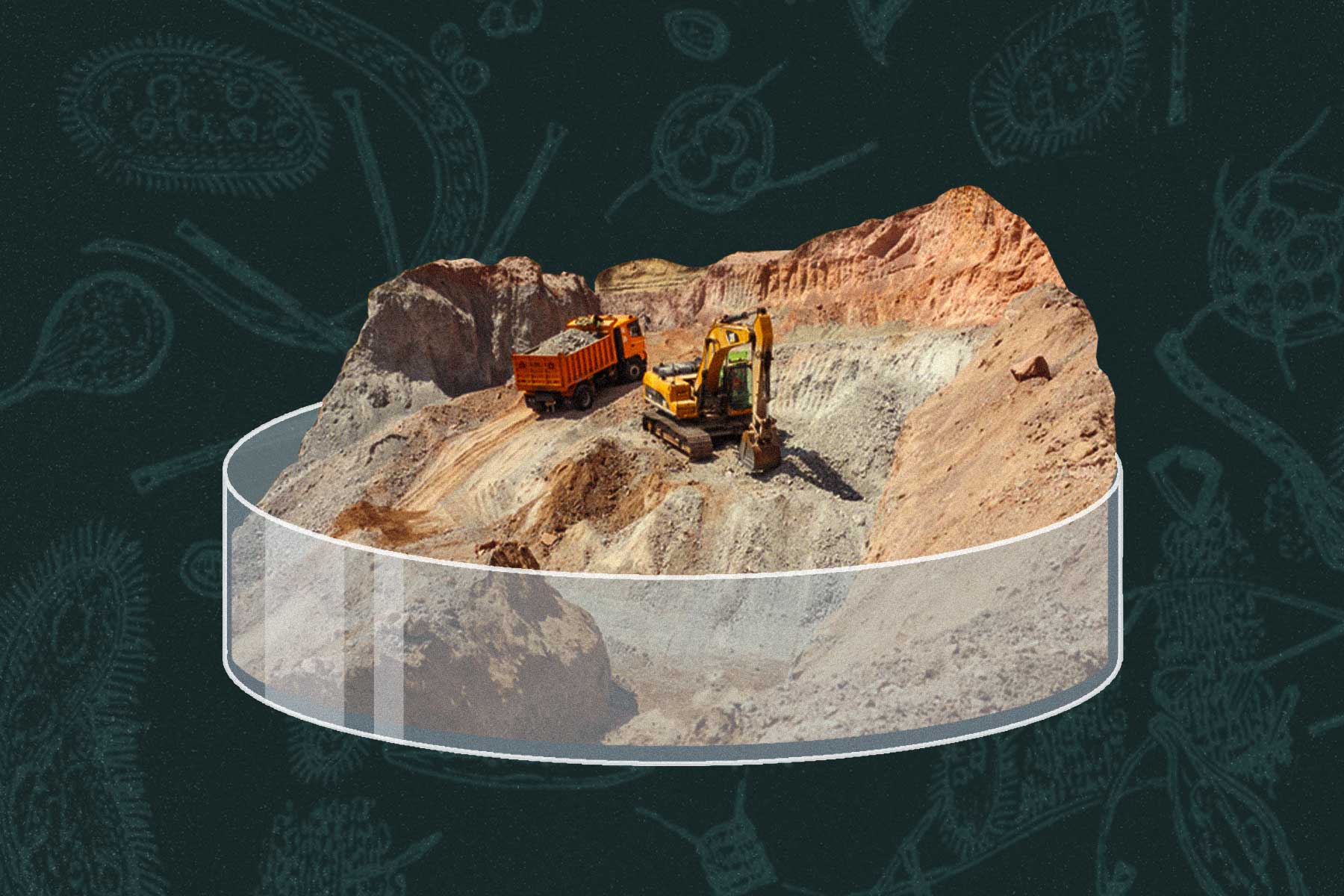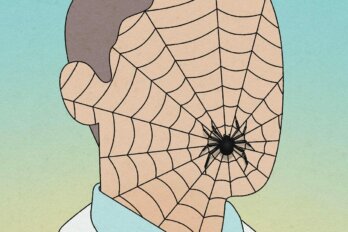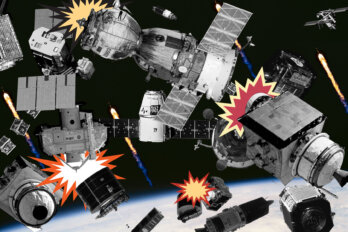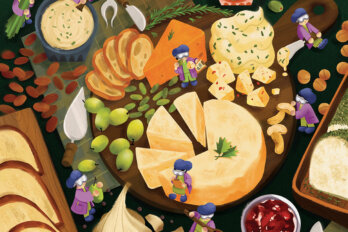When Nadia Mykytczuk first visited the mine sites near Copper Cliff, on the outskirts of Greater Sudbury, Ontario, in 2005, she saw rock piles stretching out in all directions—not so much dotting the landscape as forming their own. On first impression, says Mykytczuk, “you really can’t quite comprehend that everything you see around you is mine waste.” Some of that rubble is what is known as tailings—the crushed rock or wet slurry left behind after a company has extracted raw materials from ore. But to Mykytczuk, then a PhD student, those drab rock heaps looked a lot shinier.
Each year, Canada’s approximately 200 active mines contribute to the billions of tonnes of mining waste already accumulated in the country; that waste is then typically contained in pits or stored underground or in dams. While estimates vary wildly, there are thought to be anywhere between 1,800 and 8,500 tailing facilities worldwide. Many of them still contain some metals but at a concentration that for a long time was deemed too low to be worth extracting. So the discards mostly lie there, untouched, until someone finds another use for them. Which is what Mykytczuk has been working on over the past two decades.
Now an adjunct professor and the executive director at the Goodman School of Mines at Laurentian University, Mykytczuk is a specialist in biomining, a method by which bacteria and other microorganisms replace the chemicals that are conventionally used to extract metals from ores or remediate mine sites. This process was first harnessed for commercial purposes in the 1950s to obtain minerals such as copper from deposits with low metal concentrations or from the waste products of existing mines. It’s less energy intensive and costly than traditional mining. And now, biomining may be on the cusp of a boom: some proponents believe it could prove critical to the green energy transition that’s projected to help countries meet their emissions goals in the coming years.
“We talk about the climate crisis. We’ve actually got a mining crisis or metals crisis,” says John Steen, the director of the University of British Columbia’s Bradshaw Research Institute for Minerals and Mining. He cites S&P Global’s estimate that, in transitioning to green energy, manufacturers will need more copper in the next three decades than the world consumed over the past 120 years. Demand for copper is expected to roughly double between now and 2035, to make hardware such as rechargeable batteries, solar panel heat exchangers, and wind turbine generators. The question now is whether biomining can scale up fast enough to meet soaring demand. While it currently accounts for only around 15 to 20 percent of the world’s copper that’s extracted and 5 percent of gold, the sector is expected to grow. According to the market research and consulting firm Credence Research, biomining generated a total of $1.5 billion (US) for mining companies in 2020. The industry is expected to reach a market valuation of $3.6 billion (US) by 2027. That’s still a comparably minuscule portion of the roughly $2 trillion (US) global mining industry. But with the right technological boost, there’s potential for biomining to transform into a large-scale alternative to traditional, emissions-heavy, and often toxic metals extraction. To get there, Mykytczuk and other experts are betting on the microorganisms themselves.
Much like people, microbes work better in a community, also known as a consortium. The key to biomining is understanding every individual microorganism working for the whole. To get a sense of each microorganism’s capabilities, scientists and engineers gather samples from mine sites and sequence the DNA of the microbes within. The genetic material spells out what types of proteins the microbes are capable of producing, which helps predict how they will interact with the waste material. Ideally, that knowledge will be used to engineer consortiums that can be manipulated into extracting metals from mining waste, decontaminating it, or doing a bit of both.
When I ask Mykytczuk how the cleaning of tailings works, she counters that cleaning is a “human word.” What really happens, she says, is microbes break down elements and cause them to change states, becoming less noxious or more useful in other forms. If a mine is remediating tailing ponds full of sulphide minerals, for example—compounds of sulphur and one or more metals—microbes can help break them down and extract the components so that they can be transformed into more usable states: iron can be converted into pellets, sulphur can become sellable gypsum, and sandy materials can be used as mine backfill.
But one barrier to expanding biomining is that the types of microorganisms vary across mine sites. Until recently, biomining operations lacked an efficient way of sharing the information they learned about microorganisms’ genetic material at each mine site with other specialists around the world. In early 2022, the Digital Technology Supercluster, a group that brought together mining companies, led by the Vancouver-based Teck, UBC, genome research centres, and other partners, launched a platform that can help facilitate that knowledge exchange. The Mining Microbiome Analytics Platform (M-MAP), for which Steen is a spokesperson, allows about 100 participating scientists, engineers, and other specialists, many of whom work for mining companies, to send in samples from mine sites around the world for genetic sequencing and analysis. The genetic information is stored in a database that other users can access; the database also contains pre-existing data from public archives. With time, the accumulated data can be used to inform biomining processes.
Increasingly affordable gene-sequencing technology has helped push projects like M-MAP forward. “We can basically, with a few grand of materials, uncover the complexity of thousands of organisms in that environment,” says Mykytczuk, who isn’t involved in the project. “And we’re slowly unravelling who’s there and what they are capable of.”
That knowledge can help fine-tune consortiums for biomining. “Every tailing site, every environment, every mine site that you go to is unique,” says Mykytczuk. Genomics technologies, she says, can help “build a process around the needs of that particular material in that particular site.”
When done correctly, biomining can turn a significant profit in what would once have been seen as a money drain. For example, BacTech, a Toronto-based environmental technology company, estimates there’s $22 billion worth of metals, including nickel (which is commonly used in lithium-ion battery cathodes), in Sudbury-area tailings.
To help move the industry along faster, Mykytczuk has proposed a $21 million Centre for Mine Waste Biotechnology in Sudbury as a development and testing site for emerging mine waste biotechnologies. “I want to build a sandbox instead of a silo,” she says. “I want to invite people in, I want to engage groups to address the challenges rather than working on ideas that we want to keep to ourselves.”
No matter how much goodwill and the desire to change the unsustainable status quo are driving progress, the long-term success of biomining still comes down to the bottom line. “The prices that we’ll see in metals over the next twenty years will sustain a new industry in mining waste,” says Steen. “When the economy feels the pain of high metal prices, that’s when we develop innovations to do it cheaper and better.” That squeeze is already underway, demonstrated by some mining companies pushing for deep-sea mining despite the pleas of environmentalists and scientists claiming we need more time to understand the impacts of that activity.
A project like M-MAP, says Steen, can not only help accelerate the potential growth of biomining but also catalyze the development of other innovations. Microbial genetic information holds the potential for new technologies in the oil and gas sector, forestry, agriculture, and wastewater treatment. M-MAP’s database will be available to a range of users, with basic access available for free, so that university researchers can apply the decoded information to other industrial fields.
When I ask Steen about M-MAP’s endgame, he paints a picture of his best-case scenario. If enough people and companies start feeding their data into the platform, the combined effort could spin out companies doing crucial work, “from rare-earth extraction to cleaning up mines to capturing carbon dioxide in waste,” he says. “There’ll be nothing else in the world that’s as powerful as this, and it will just get more and more powerful.”





